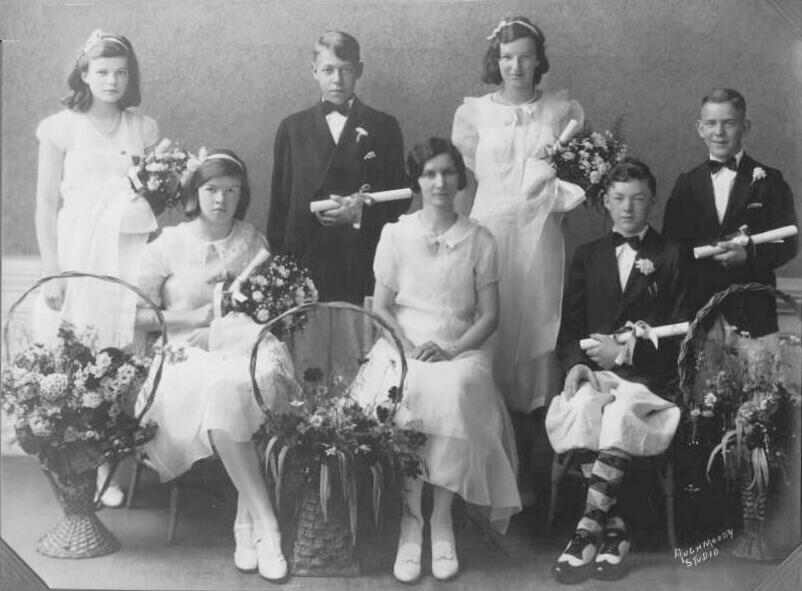
American Knee Socks: Conventions

Figure 1.--I at first thought this was an 8th grade graduation because of the scrolls. I think now that it may have been a Lutheran confirmation. Children at a school would have been less likely to have dressed so simiarly. The children would have been about 13 years old. The photographic studio was in Albany and other update New York cities. The portrait is undated, but was probably taken avout 1930. Note the loud kneesocks.
|
The convebntions associated with kneesocks are a little complicated and difficult to assess. American boys in the late 19th century mostly wore long stockings and to a much lesser extent three-quater socks. We rarely note boys wearing kneesocks. The first common usage of kneesocks seems to have been the Boy Scouts. The Scouts were founded in 1909 and the uniform was knicker-like breeches worn with kneesocks. This was an oit door, active usage. At the time boys mostly wore kneepants or knickers. Younger boys might wear three-quarter socks, but long stockings were more common. Many boys in the early 20th century commonly went barefoot during the summer. We note some mostly younger boys wearing kneesocks with short psnts during the 1920s, but knickers were more common and commonly worn with long stockings. Gradually kneesocks became more common, especially by the 1930s. Even in the 1930s long stockings were considered more formal. Kneesocks with their bold patterns were seen as more od a casual, sporty style. But they were not populae with older boys so kneesocks became increasingly worn, even for formal occassions. And because kneesocks came in many patterns you see some boys wearing rather flashy patterns even with conservative dark suits for formal occassions. An example here is boys wearing conservative suits for their confirmation in 1932. While long stockings came in solid colors, kneesocks came in all sorts of patterns. Boys also wore knickers for school. Here long stockings were common in the 1920s, but kneesocks by the 30s. Boys often wore argyles or other bright pattern kneesocks. By the end of the 1930s kneesocks were becoming much less common. We see many boys wearing knickers with ankle socks. More boys wearing long pants and many boys wearing knickers with ankle socks. While most boys wore knicker suits, some boys wore short pants suits. Many boys wore short pants suits with ankle suits. This was rarely seen in Europe. After knickers disappeared, American boys mostly wore short socks in the 1950s, both when dressing up and for play. By the 1960s short pants suits became less common, but boys wearing them commonly wore knee socks. Knee socks by this time were seen as a dressy style. Boys rarely wore knee socks for play or casual wear. We also see boys wearing short pants for play, but kneesocks were not commonly worn for play.
HBC

Navigate the Boys' Historical Clothing Web Site:
[Return to the Main U.S. kneesocks page]
[Return to the Main kneesock page]
[Introduction]
[Activities]
[Biographies]
[Chronology]
[Clothing styles]
[Countries]
[Topics]
[Bibliographies]
[Contributions]
[FAQs]
[Glossaries]
[Satellite sites]
[Tools]
[Boys' Clothing Home]
Created: 9:42 PM 10/20/2006
Last updated: 9:43 PM 10/20/2006



